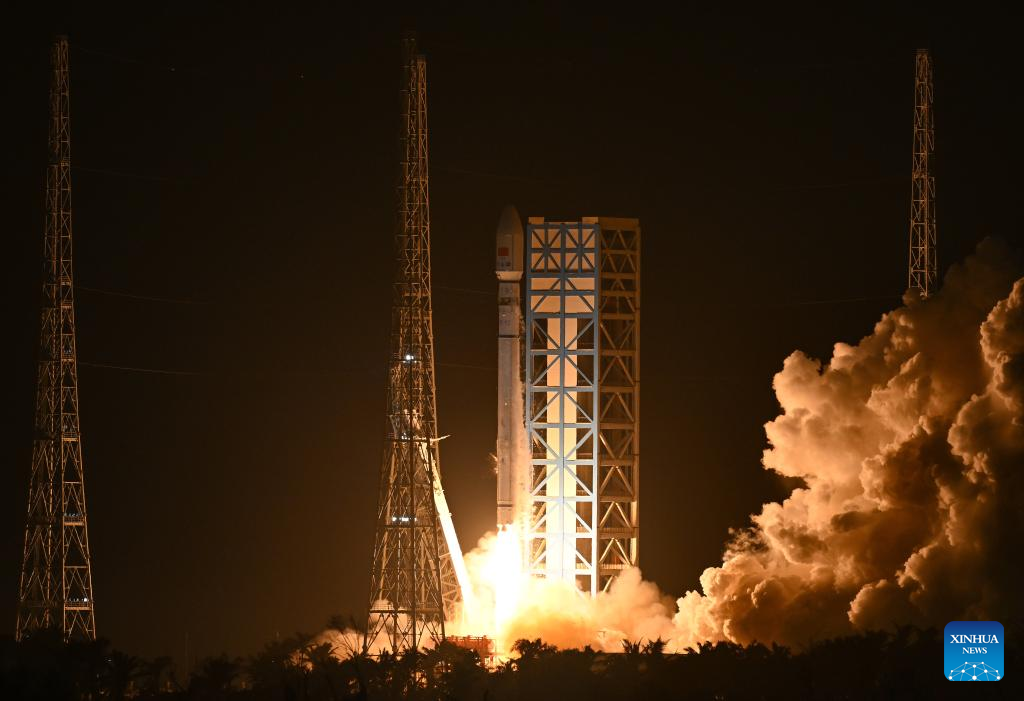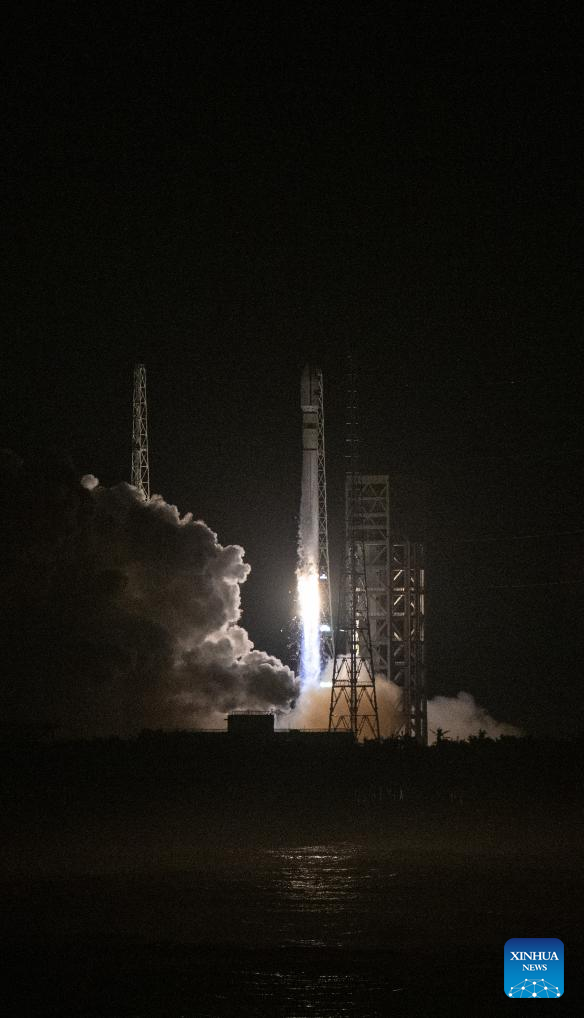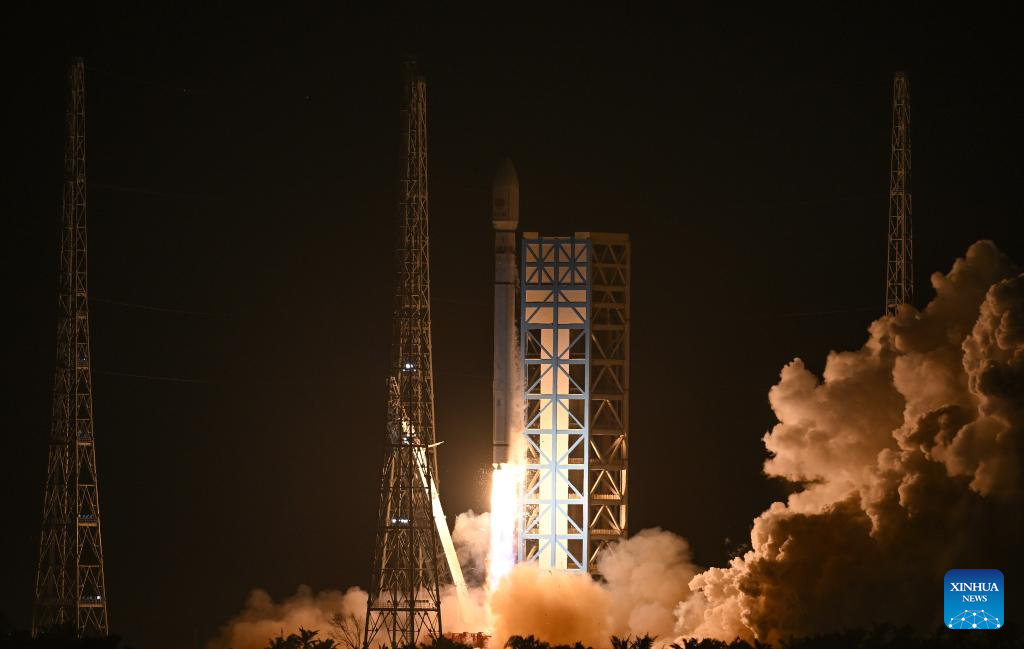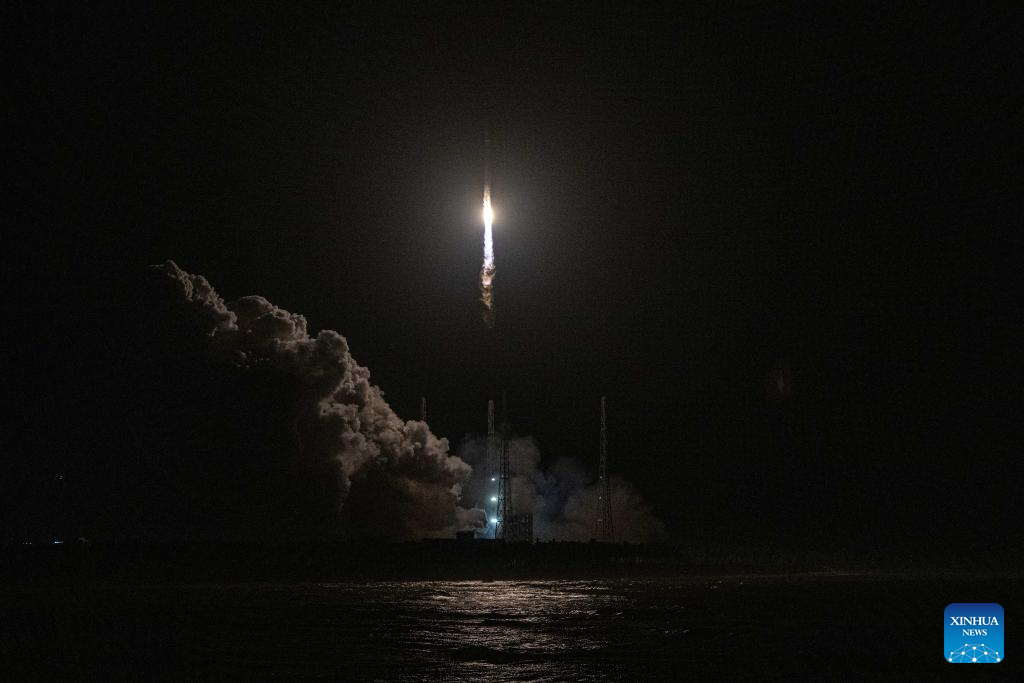1.12.2024

A Long March-12 carrier rocket carrying two experimental satellites blasts off from the Hainan commercial spacecraft launch site in the southern island province of Hainan, Nov. 30, 2024. China on Saturday night successfully launched a new carrier rocket into space from the Hainan commercial spacecraft launch site in the southern island province of Hainan. The Long March-12 carrier rocket sent two experimental satellites into their planned orbits. The mission was the maiden flight of the Long March-12 carrier rocket, and the first launch mission undertaken by the Hainan commercial spacecraft launch site. (Xinhua/Guo Cheng)
China launched a new carrier rocket into space on Saturday night from the Hainan commercial spacecraft launch site on the southern island province of Hainan.
The Long March-12 carrier rocket sent two experimental satellites into their planned orbits. The launch mission was a complete success, according to Hainan provincial authorities.
The rocket was developed by the Shanghai Academy of Spaceflight Technology under the China Aerospace Science and Technology Corporation. With a length of about 62 meters and a diameter of 3.8 meters, it features a two-stage design. It is currently the country's largest single-core carrier rocket in payload capacity.
The rocket is designed with a carrying capacity of no less than 12 tonnes in low Earth orbit and no less than 6 tonnes in 700-km sun-synchronous orbit.
It achieves an optimal match between the diameter of the rocket body and the number of engines, with its first stage using four liquid oxygen-kerosene engines, which not only increases its carrying capacity but also allows for the transport of the rocket by railway to various launch sites across the country.
The rocket also uses a series of new technologies, including rocket health diagnostics management, cold helium pressurization, and aluminum-lithium alloy tanks. Its fairing has standard diameter configurations of 4.2 meters and 5.2 meters, which can be adapted to different mission requirements.
The Long March-12 carrier rocket is ready for frequent launch missions. It will effectively enhance China's ability to place satellites into sun-synchronous orbits and set up a multi-constellation network in low Earth orbit.
Saturday's launch was the 548th flight mission of the Long March rocket series.
Quelle: Xinhua
+++
China's seaside commercial spacecraft launch site completes first mission
China on Saturday successfully launched a new carrier rocket into space from the Hainan commercial spacecraft launch site in the southern island province of Hainan.
The Long March-12 carrier rocket blasted off at 10:25 p.m. (Beijing Time) from the site's No. 2 launch pad, and sent two experimental satellites into their planned orbits.
The launch mission achieved complete success at 10:48 p.m., according to Hainan provincial authorities.
The mission was the maiden flight of the Long March-12 carrier rocket, and the first launch mission undertaken by the Hainan commercial spacecraft launch site.
The construction of the launch site, which is the first to be built for commercial missions in China, commenced in July 2022.
With investment of over 4 billion yuan (about 553 million U.S. dollars), the launch site was built and is being operated by the Hainan International Commercial Aerospace Launch Co., Ltd. (HICAL).
It includes a launch area, a TT&C (telemetry, tracking and command) building, rocket assembly buildings, spacecraft testing facilities, fuel storage facilities and other structures.
LOCATION ADVANTAGES
The launch site is located at a latitude of 20 degrees north, benefiting from the advantages of this low latitude, which can increase rocket payload capacities and reduce rocket fuel costs.
The site is located off the coast of Wenchang City, making it more convenient and safer than inland launch sites as large rockets can be transported to site by ship, which is very important for commercial launch services. The Hainan provincial government is also planning a new, purpose-built port.
The coastal location is also an advantage for HICAL's recovery of reusable rockets after launch. The company is working with commercial rocket developers on experiments related to vertical landings and the recovery of rockets from the sea.
The site currently has two launch pads for liquid propellant rockets. The No. 1 pad is designed for the Long March-8, China's new generation medium-lift carrier rocket. The No. 2 pad is capable of launching multiple types of rockets with various diameters from commercial rocket companies. Each pad has an annual capacity of 16 launches.
The site's propellant and gas supply system is capable of refueling and supplying liquid oxygen, liquid hydrogen, kerosene and methane.
GROWING INDUSTRIAL CHAIN
The launch site will also accelerate the cultivation of the commercial space industry and talent in Hainan, with industrial chains covering spacecraft R&D, launch services and satellite applications. Such integration is conducive to the future high-quality development of the island province.
Domestic space companies such as i-Space, Galactic Energy, LandSpace, Space Pioneer and CAS Space have either established facilities in Hainan or plan to do so. In one example, the China Aerospace Science and Technology Corporation's China Academy of Launch Vehicle Technology has built a Long March-8 rocket assembly plant in Hainan, with an annual output of 50 rockets.
Deep Blue Aerospace will build rocket and satellite assembly and testing facilities, as well as first-stage recovery plants and supporting infrastructure around the launch site. This will enable rockets to be launched immediately after they are completed at the plant, boosting launch efficiency significantly and reducing costs.
Aerospace talent pool has also been building in Hainan in recent years, including Chen Shuai, a dispatch supervisor at the launch site.
Born in 1995 in Hainan's Chengmai County, Chen has been particularly interested in astronomy and aerospace since childhood. When he studied at the University of Science and Technology of China, he chose the department of thermal science and energy -- a discipline related to aerospace.
The growing commercial space industry attracted him to return to his home province in 2021 to join the launch site's development team. Many of his university classmates now work in commercial space companies, including firms in Hainan.
FUTURE PROSPECTS
Among the two satellites launched Saturday, one is an experimental satellite for satellite internet service developed by GalaxySpace, a unicorn company based in Beijing. It has developed China's first type of flat satellite using flexible solar wings and achieved the mass production of low-orbit broadband communication satellites.
Following the launch mission on Saturday, the site plans to launch a Long March-8 carrier rocket from its No. 1 launch pad around the end of the year.
The commercial space industry was included in China's government work report for the first time this year. It was listed among the "emerging industries and future-oriented industries" that the government plans to cultivate.
At a forum on the commercial space industry held earlier this month in Zhuhai, south China's Guangdong Province, Li Guoping, chief engineer at the China National Space Administration, disclosed that the country is mapping a development plan for civil space infrastructure from 2026 to 2035.
He said that the commercial space industry should be included in the overall layout of China's space development, and expressed support for commercial satellite exports, commercial data application and international commercial launch services.
According to the 2023 China aerospace science and technology blue book, the country completed 26 commercial launches in 2023, accounting for 39 percent of its total launches.
China's commercial space market has maintained rapid growth since 2015, with an average annual growth rate of more than 20 percent from 2017 to 2024. It is estimated that its market value will be about 2.34 trillion yuan by 2024. ■

A Long March-12 carrier rocket carrying two experimental satellites blasts off from the Hainan commercial spacecraft launch site in the southern island province of Hainan, Nov. 30, 2024. China on Saturday night successfully launched a new carrier rocket into space from the Hainan commercial spacecraft launch site in the southern island province of Hainan. The Long March-12 carrier rocket sent two experimental satellites into their planned orbits. The mission was the maiden flight of the Long March-12 carrier rocket, and the first launch mission undertaken by the Hainan commercial spacecraft launch site. (Xinhua/Pu Xiaoxu)

A Long March-12 carrier rocket carrying two experimental satellites blasts off from the Hainan commercial spacecraft launch site in the southern island province of Hainan, Nov. 30, 2024. China on Saturday night successfully launched a new carrier rocket into space from the Hainan commercial spacecraft launch site in the southern island province of Hainan. The Long March-12 carrier rocket sent two experimental satellites into their planned orbits. The mission was the maiden flight of the Long March-12 carrier rocket, and the first launch mission undertaken by the Hainan commercial spacecraft launch site. (Xinhua/Guo Cheng)

A Long March-12 carrier rocket carrying two experimental satellites blasts off from the Hainan commercial spacecraft launch site in the southern island province of Hainan, Nov. 30, 2024. China on Saturday night successfully launched a new carrier rocket into space from the Hainan commercial spacecraft launch site in the southern island province of Hainan. The Long March-12 carrier rocket sent two experimental satellites into their planned orbits. The mission was the maiden flight of the Long March-12 carrier rocket, and the first launch mission undertaken by the Hainan commercial spacecraft launch site. (Xinhua/Pu Xiaoxu)
Quelle: Xinhua
